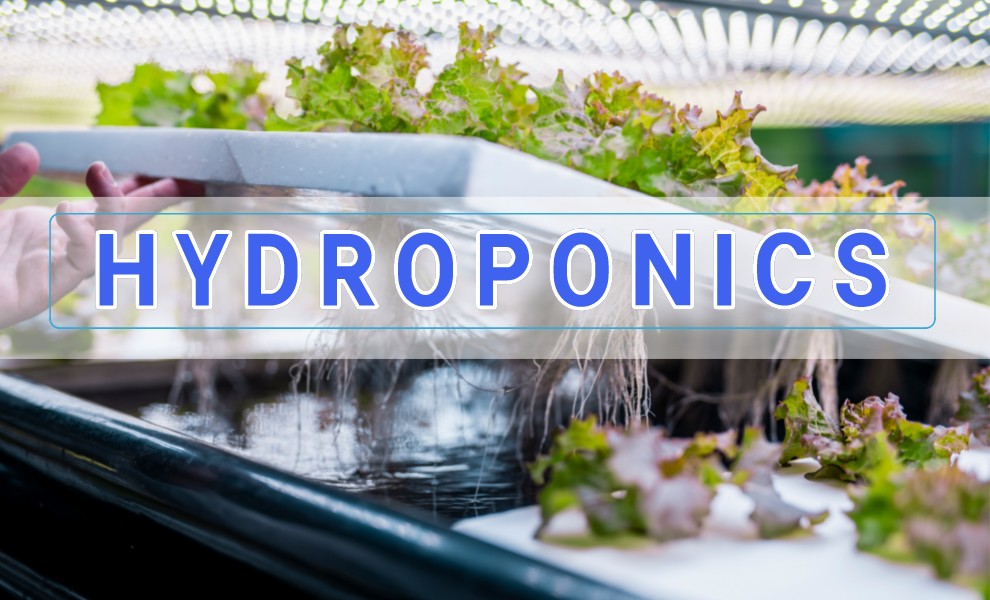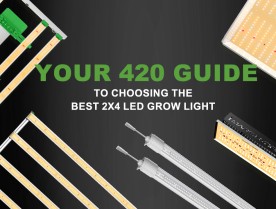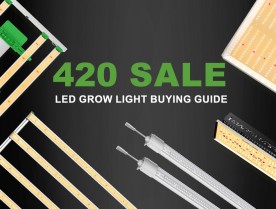
In recent years, hydroponic systems have revolutionized the way we think about farming, extending their innovative approach to the cultivation of weed. Hydroponic weed, grown in a soilless medium, is gaining popularity due to its efficiency, control, and potentially superior quality.
You've probably heard of many weed cultivators using hydroponics for fast & massive results. Many cultivators in the vertical farming movement also believe hydroponic setups will be vital to meeting the growing demand for legal weed.
While hydroponics has been around since antiquity, some cultivators may not fully understand why they should consider using it. Every weed cultivator should take a minute to review the basics of hydroponic systems and compare them with more traditional soil pots.
What is Hydroponic Weed?
Hydroponic weed cultivation is a process where weed is grown in a soil-free system, focusing on nutrient-rich solutions to sustain the plants. Unlike traditional methods that use soil, hydroponic weed systems involve suspending the plants' roots in either a water-based solution or using inert mediums such as rockwool, clay pellets, peat moss, or perlite. This approach allows growers to precisely control the nutritional intake and environment of the plants.
Different hydroponics setups like Deep Water Culture (DWC), Nutrient Film Technique (NFT), and Ebb and Flow can be used for cultivating weed. These systems provide hydration and nutrients through various means, including pumps, attached strings, or misting techniques.
Hydroponics, by not relying on soil, offers weed growers enhanced control over their cultivation environment. However, it also demands greater responsibility in monitoring nutrient concentrations and pH levels in the hydroponic reservoir. Despite these challenges, many advocates of hydroponic weed cultivation find the extra effort worthwhile for the level of precision it offers in managing plant growth.
Advantages of Hydroponic System in Growing Plants
-
Enhanced Control and Precision: Hydroponic weed cultivation offers unparalleled control over the growing environment. Using only inert materials, water, and nutrient solutions in a hydroponic system, growers eliminate the unpredictability of soil-based nutrients. This precision leads to less room for error but guarantees a more controlled cultivation process.
-
Efficient Nutrient Delivery: Hydroponic systems provide plants with a nutrient solution rich in essential minerals, ensuring optimal growth. This tailored approach caters to the specific nutritional needs of weed at different growth stages.
-
Controlled Growing Conditions: The ability to precisely manage environmental factors like temperature, humidity, and light in a hydroponic setup mimics natural growth cycles and reduces issues like mold.
-
Enhanced Growth and Yield: Growers using hydroponic weed systems often experience faster growth and higher yields due to efficient nutrient absorption. Compared to soil cultivation, hydroponics accelerates weed maturity and nutrient uptake.
-
Space and Water Efficiency: Hydroponic systems are ideal for indoor cultivation, offering space-saving solutions and water efficiency.
-
Reduced Pest and Disease Risk: The absence of soil significantly lowers the risk of soil-borne pests and diseases, although hydroponics may face challenges like algae growth.
Challenges and Considerations in Hydroponic System
-
Technical Knowledge Requirement: Successful hydroponic weed cultivation demands an understanding of plant nutrition and the intricacies of hydroponic systems.
-
Initial Hydroponic Setup and Maintenance Costs: Setting up a hydroponic system typically involves a higher initial investment compared to traditional soil setups. Maintenance and monitoring of the system, especially for balanced nutrient solutions, are crucial.
-
Resource Usage: Hydroponic units can increase electricity and water costs. Supplemental nutrients are also necessary, adding to the operational expenses.
-
Balancing Efficiency and Costs: While hydroponics offers better yields and faster flowering times, the added costs and responsibilities of managing such systems must be weighed. For many, the benefits of greater predictability and efficiency in weed hydroponics justify these expenses.
By understanding these advantages and challenges, cultivators can make informed decisions about whether a hydroponic system is the right approach for their needs of growing plants. This knowledge is key to leveraging the sophisticated and efficient capabilities of hydroponic weed cultivation.
How Do You Choose Hydroponic System? — A Quick Review Of The Top Six Options
So far, you may have gotten the impression there's just "one" hydroponic system. However, when you start researching different hydroponics, you'll quickly realize there are significant differences in each system's design. While every hydroponic unit doesn't rely on soil, they each have unique pros & cons.
Below, we'll quickly run through the six primary hydroponic techniques to help you better assess which would be suitable for your grow space.
Wicking
We'll start with what's arguably the most "beginner-friendly" hydroponics technique: wicking. Indeed, wicking is so great for novices that elementary schools often teach kids about plants using this method. Perhaps you used this technique in school without even knowing it!
In this hydroponic system, plants are in inert matter above a reservoir. The "wick" refers to a string that carries nutrients and water in the reservoir to the plant's roots.
Although this method is easy to set up, it's only recommended for gardeners with a few plants. Wicking may be inexpensive and straightforward, but it's not an efficient method for people who want to grow medium or large amounts of crops.
Deep Water Culture (DWC)
Deep Water Culture (DWC) is a popular hydroponic method where plants' roots are suspended directly above water in a reservoir. This system typically involves placing plants in netted pots filled with inert matter and ensuring adequate oxygenation through air stones. DWC is celebrated for its simplicity and cost-effectiveness, making it a suitable choice for both beginners and experienced hydroponic gardeners. However, growers should be aware of the potential risk of root suffocation due to the plants' constant exposure to water.
The Mars Hydro 5-Gallon DWC Hydroponic Growing System Kit offers an excellent balance of efficiency, control, and quality, making it an ideal choice for those interested in DWC hydroponics, particularly for weed cultivation. Its combination of essential features and user-friendly design positions it as a top choice for gardeners seeking a reliable, soilless gardening solution.
Features of the Mars Hydro 5-Gallon DWC Hydroponic System
- Comprehensive DWC Kit: This kit includes two 5-gallon PP plant buckets, 8-inch grow baskets, and a top-feed drip irrigation system, ensuring a consistent delivery of nutrient-rich water to the plants.
- Essential Components Included: It comes equipped with an air pump, air tubing, high-efficiency air stones, clay pebbles, visual water level indicators, valve connections, and an instruction booklet for easy setup.
- Durable and Efficient Design: Crafted with superior PP material, the kit is built for durability. The optimized airflow provided by the air pump and air stone ensures ideal oxygenation for the plants.
Advantages of Using the Mars Hydro 5-Gallon DWC System
- Enhanced Plant Growth: Designed to maximize growth rates and nutrient absorption, the system is ideal for robust plant development.
- Versatility and Accessibility: The kit is user-friendly, catering to both novice and professional hydroponic gardeners.
- Indoor and Outdoor Flexibility: Its versatility makes it perfect for various environments, including grow tents, greenhouses, and urban spaces like patios and balconies.
- Year-Round Cultivation: Allows for the growing of fresh, organic produce throughout the year, regardless of external soil and seasonal conditions.
- Space-Efficient: Its compact design makes it especially suitable for urban gardening and areas with limited space.
Nutrient Film Technique (NFT)
In the hydroponics world, "NFT" has nothing to do with a bored monkey. Instead, this acronym stands for the "nutrient film technique" system.
Although NFT gardening resembles DWC, plants aren't grown directly over a reservoir. Instead, this setup pushes nutrient-rich water from the reservoir into a slanted chamber where your plants are resting in net pots. Gradually, the water will leave this chamber and head back to the reservoir in pre-timed intervals.
The benefit of NFT gardening is that it avoids the risk of suffocating your plants' roots. However, NFT units tend to be more costly to maintain, and it's easy for this nutrient-dense water to cause congestion issues in the connecting pipes.
Ebb & Flow
Like NFT hydroponics, ebb & flow systems deliver water and nutrients from a reservoir to your plants' roots at timed intervals. However, while the water in NFT chambers steadily trickles away thanks to the chamber's incline, ebb & flow delivers a blast of water and nutrients on a flat surface.
Some people find ebb & flow can be too shocking for plants, while others contend it's a far more energy-efficient option than aeroponics. Just keep in mind there's a risk ebb & flow systems could submerge plants' delicate roots if improperly managed.
Aeroponics
Aeroponics is one of the easiest hydroponics systems to understand, but it's the most difficult to get right. In this system, cultivators use timed bursts of mist to supply their plants with plenty of hydration and nutrition without a high risk for over-saturation. Since plants are well-oxygenated in aeroponics systems, they virtually eliminate the risk of suffocation.
Unfortunately, aeroponics is also one of the most costly hydroponics units. While people often love the precision aeroponics units offer, adding them to your garden will be a significant investment.
Drip Systems
The last hydroponics system on our list is arguably the most common in professional weed cultivation. Drip systems involve plants suspended over a reservoir attached to "drip emitters." A pump will send water from the reservoir through these emitters to "drip" water on your plants' roots. Any excess water is then recirculated back to the reservoir.
Large-scale growers love how easy it is to scale and maintain drip systems compared with other setups. Drip systems may not offer the same precision as aeroponics, but they're cheaper to set up on a wide scale. This isn't the best choice for smaller weed cultivators, but it's arguably the best option for professional commercial growers.
Each hydroponic system offers distinct benefits and challenges. Factors like your scale of operation, budget, and technical expertise will play a significant role in determining the best choice for you to grow weed. By carefully assessing each system's features, you can make an informed decision to achieve optimal growth and yield in your hydroponic gardening endeavors.
Setting Up Your Hydroponic System
Want To Give Hydroponic Growing A Try? Check Out Mars Hydro's Hydroline12!
If you're wondering whether hydroponic systems are right for you, we'd strongly encourage you to look into Mars Hydro's new Hydroline12.
This countertop system has everything you need to start experimenting with basic hydroponics. Each of the 12 growing domes are above a six-liter tank equipped with an ultra-quiet air pump. Plus, the Hydroline12 is attached to one of Mars Hydro's famous LED panels. Key features and functions of this system include:
- LED Grow Light: It comes with a full-spectrum LED grow light, providing essential lighting for seedlings and vegetables. This light supports two growth modes, vegetable and flower, with different spectral settings to promote various stages of plant growth.
- Hydroponic Garden Kit: The system includes a cloning machine with 12 pods, allowing the cultivation of up to 12 different plants simultaneously. It's suitable for a soilless growing environment, which can lead to faster plant growth compared to soil planting.
- Nutrient Delivery and Oxygenation: A powerful water pump is included to mix the nutrient solution with oxygen, enhancing root absorption and growth. The system operates on a timed cycle to ensure efficient nutrient delivery.
- Large Capacity Water Tank: The kit features a 6-liter water tank, capable of holding enough nutrient solution for up to 15 days of continuous plant use, reducing the need for frequent replenishment.
- Adjustable Settings: With five luminosity settings and four timing options, the system allows for precise control over the growing environment, catering to the specific needs of different plant stages.
- Memory Function: The system includes a power-off memory function, ensuring that it will continue operating in the same mode and settings after a power outage.
This kit is particularly beneficial for those looking to grow weed or other plants in a controlled, soilless environment, offering a balance of efficiency, control, and quality of produce.
Even if you have zero experience with hydroponic growing, the intuitive Hydroline12 will ensure your first experience with hydroponics is super successful.
Legal Considerations
When considering the cultivation of weed, it's essential to have a thorough understanding of and strict adherence to local laws and regulations. These legal guidelines can vary significantly by region, country, or state, and may encompass a variety of aspects including:
- Cultivation Limits: There might be restrictions on the number of plants you can grow or the amount of weed you can possess.
- Licensing Requirements: Some regions require growers to obtain specific licenses or permits.
- Zoning Laws: There may be regulations on where you can grow weed, such as distances from schools or public areas.
- Age Restrictions: Legal cultivation is often limited to individuals above a certain age, typically 18 or 21.
- Sale and Distribution Laws: Laws often distinguish between cultivation for personal use and for commercial purposes, with different regulations for each.
- Taxation and Reporting Requirements: Legal weed cultivation might entail tax obligations and mandatory reporting of your activities to authorities.
- Compliance with Safety and Quality Standards: There may be stipulations regarding the safety, quality, and testing of the weed you grow.
Non-compliance with these laws can result in severe legal consequences, including fines, criminal charges, and imprisonment. Therefore, it's imperative for anyone considering weed cultivation to seek legal advice and ensure full compliance with all local regulations.
The Future of Hydroponic Growing
With the growing acceptance of legalization and technological advancements, hydroponic weed cultivation is on the brink of becoming a more prevalent practice. This method, known for its efficiency and high-quality weed production, is gaining popularity among both commercial and individual growers.
Hydroponic cultivation marks a transformative era in weed farming, offering the advantages of enhanced yields, meticulous quality control, and environmental sustainability. As the weed industry continues to evolve, hydroponic methods are expected to be at the forefront of this agricultural revolution.
Successful hydroponic weed cultivation hinges on thorough research, a deep understanding of the chosen system, and adherence to local legal regulations. Here's to fruitful hydroponic cultivation!











